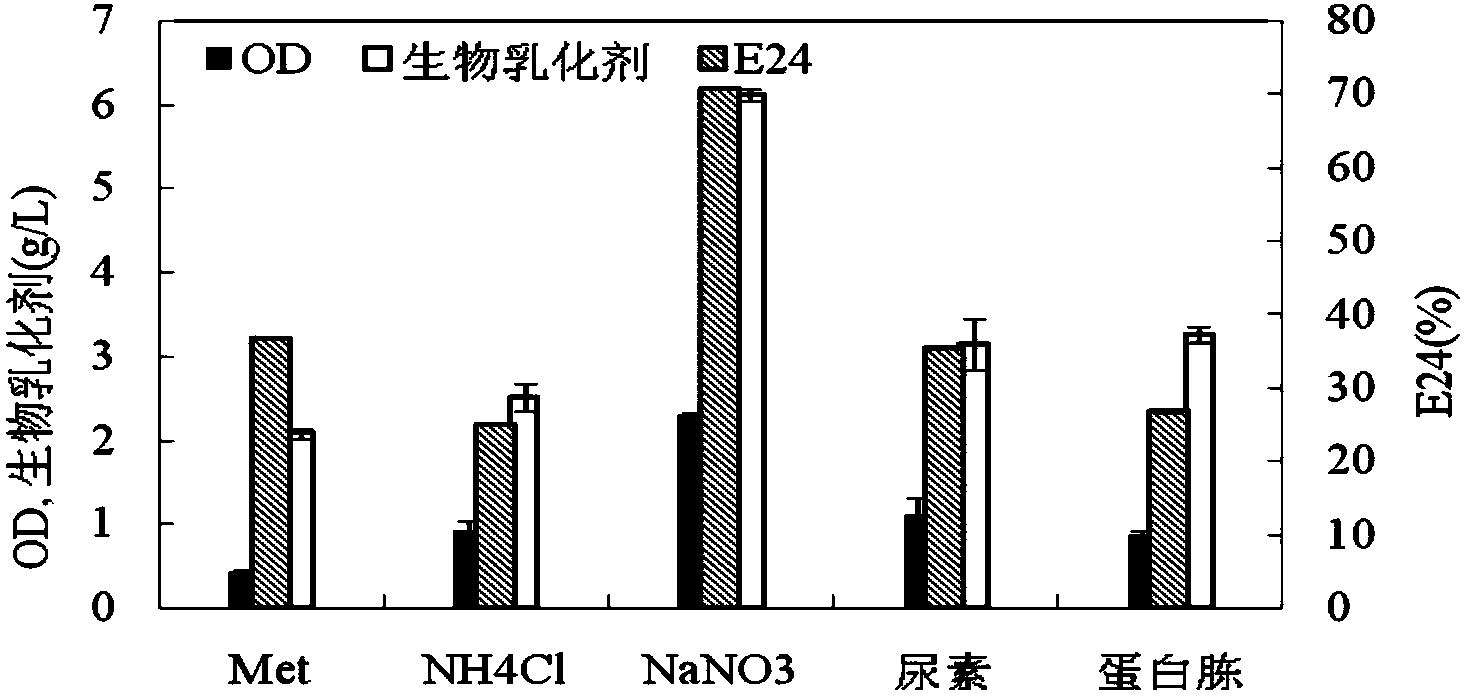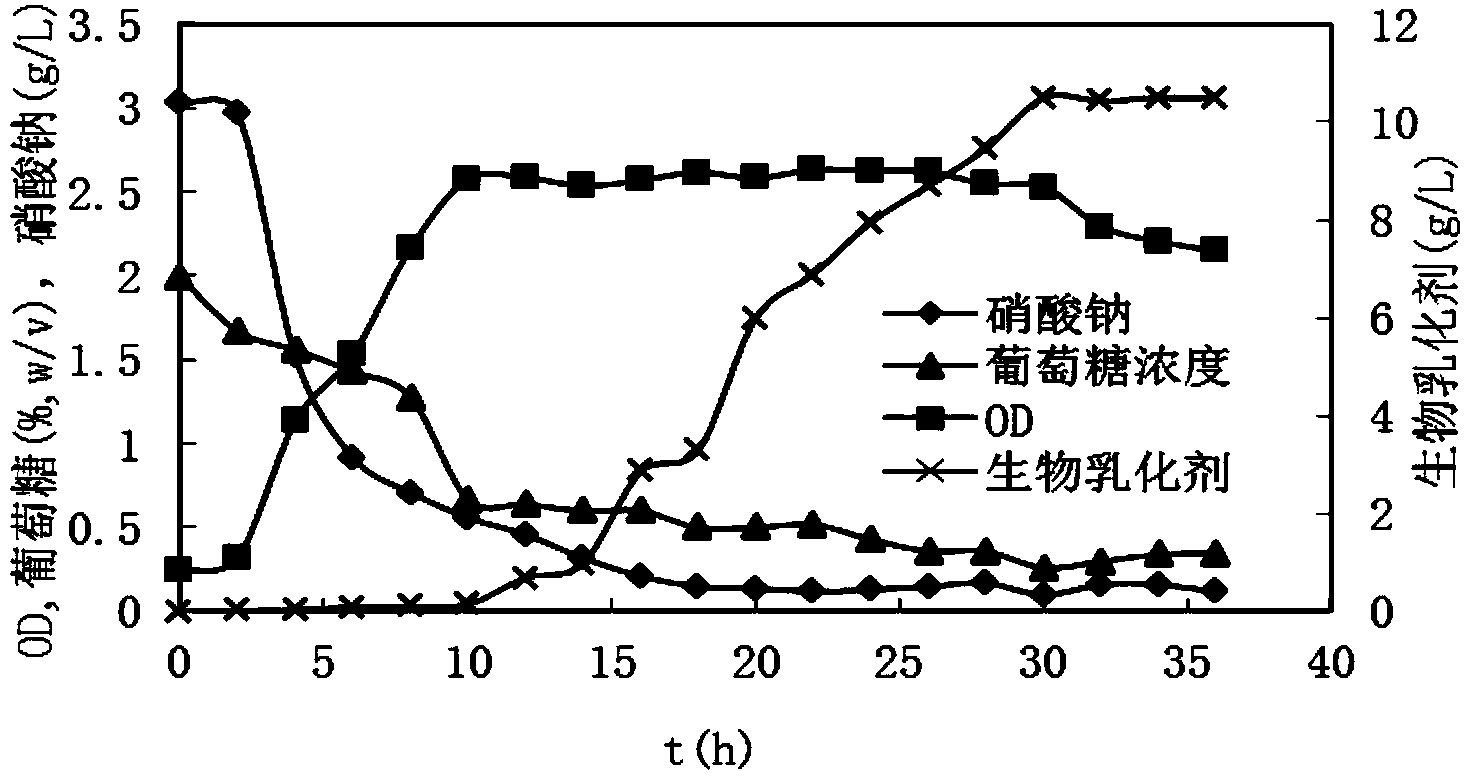Active thermophilic bacterial strain and applications thereof
A technology of thermophilic microorganisms and biological emulsifiers, which is applied to bacteria, mining fluids, microorganisms, etc., can solve the problems such as the inability of microorganisms to grow normally, poor environmental adaptability, and unsatisfactory use effects, and achieve low production costs and adaptability. Strong, enhanced oil recovery effect
- Summary
- Abstract
- Description
- Claims
- Application Information
AI Technical Summary
Problems solved by technology
Method used
Image
Examples
Embodiment 1
[0020] Embodiment 1: the screening of biosurfactant bacterial strain
[0021] The activity characteristics of thermophilic microorganisms depend on the particularity of their growth environment. Oil-contaminated soil samples from the Yaerxia oil reservoir in Yumen Oilfield, Gansu, China were shaken and mixed with 5 times the volume of sterile saline, and 100 μl of soil was suspended. The turbid liquid was coated on a solid LB plate, and cultured in an incubator at 60°C for 3 days. Picked a single clone, and re-streaked on the LB plate for separation and purification until the purified single clone was obtained. It was found by Gram staining that the strain XS2 was Gram The strain XS2 was found to be short rod-shaped with spores by microscope observation; the semi-solid puncture inoculation test showed that the strain XS2 was facultative anaerobic, and the results of nitrate reduction and lipid hydrolysis tests were positive. Cellular DNA was extracted, and the 16S rRNA gene wa...
Embodiment 2
[0022] Example 2: Activity and emulsifier performance of bacterial strain Geobacillus sp.XS2
[0023] 1. Bacterial liquid preparation: LB plate was coated with seed liquid, and LB medium was prepared as follows (w / v): 1% peptone, 0.5% yeast extract, 1% sodium chloride, 2% agar powder added to solid medium, pH7 .5, place it upside down in a constant temperature incubator at 60°C and cultivate overnight. Pick a single colony, streak it onto a fresh LB plate, and repeat 2 to 3 times to obtain pure bacteria. Inoculate the strain in a 500mL Erlenmeyer flask containing 2% (w / v) crude oil inorganic salt medium, 180rpm, 60°C shaking culture, the inorganic salt formula is as follows: glucose 2%, sodium nitrate 0.3%, potassium dihydrogen phosphate 0.042 %, dipotassium hydrogen phosphate 0.12%, ferrous sulfate 0.005%, magnesium sulfate 0.05%, calcium chloride 0.005%, medium pH 7.5. The crude oil culture medium is that the glucose in the above-mentioned inorganic salt culture medium is ...
Embodiment 3
[0030] Embodiment 3: Optimum fermentation condition optimization of bacterial strain Geobacillus sp.XS2
[0031] 1. Screening of carbon and nitrogen sources. Strain XS2 can utilize various carbon sources such as sugars, organic acids, alcohols, lipids, and hydrocarbons for growth. When using glucose as a carbon source, the cell growth rate and emulsifying activity are the highest, and the emulsifier production is also the highest, as follows figure 1 shown. At the same time, the effects of 5 kinds of nitrogen sources on the synthetic emulsifier of the bacteria XS2 were screened as follows figure 2 It was shown that when sodium nitrate was used as nitrogen source, the emulsifying activity of fermentation broth and the output of emulsifier were the highest. Therefore, glucose and sodium nitrate were selected as the best carbon and nitrogen sources for the fermentation production of bioemulsifiers.
[0032] Further studies have proved that under the condition of 2% glucose, wh...
PUM
 Login to View More
Login to View More Abstract
Description
Claims
Application Information
 Login to View More
Login to View More - R&D
- Intellectual Property
- Life Sciences
- Materials
- Tech Scout
- Unparalleled Data Quality
- Higher Quality Content
- 60% Fewer Hallucinations
Browse by: Latest US Patents, China's latest patents, Technical Efficacy Thesaurus, Application Domain, Technology Topic, Popular Technical Reports.
© 2025 PatSnap. All rights reserved.Legal|Privacy policy|Modern Slavery Act Transparency Statement|Sitemap|About US| Contact US: help@patsnap.com



